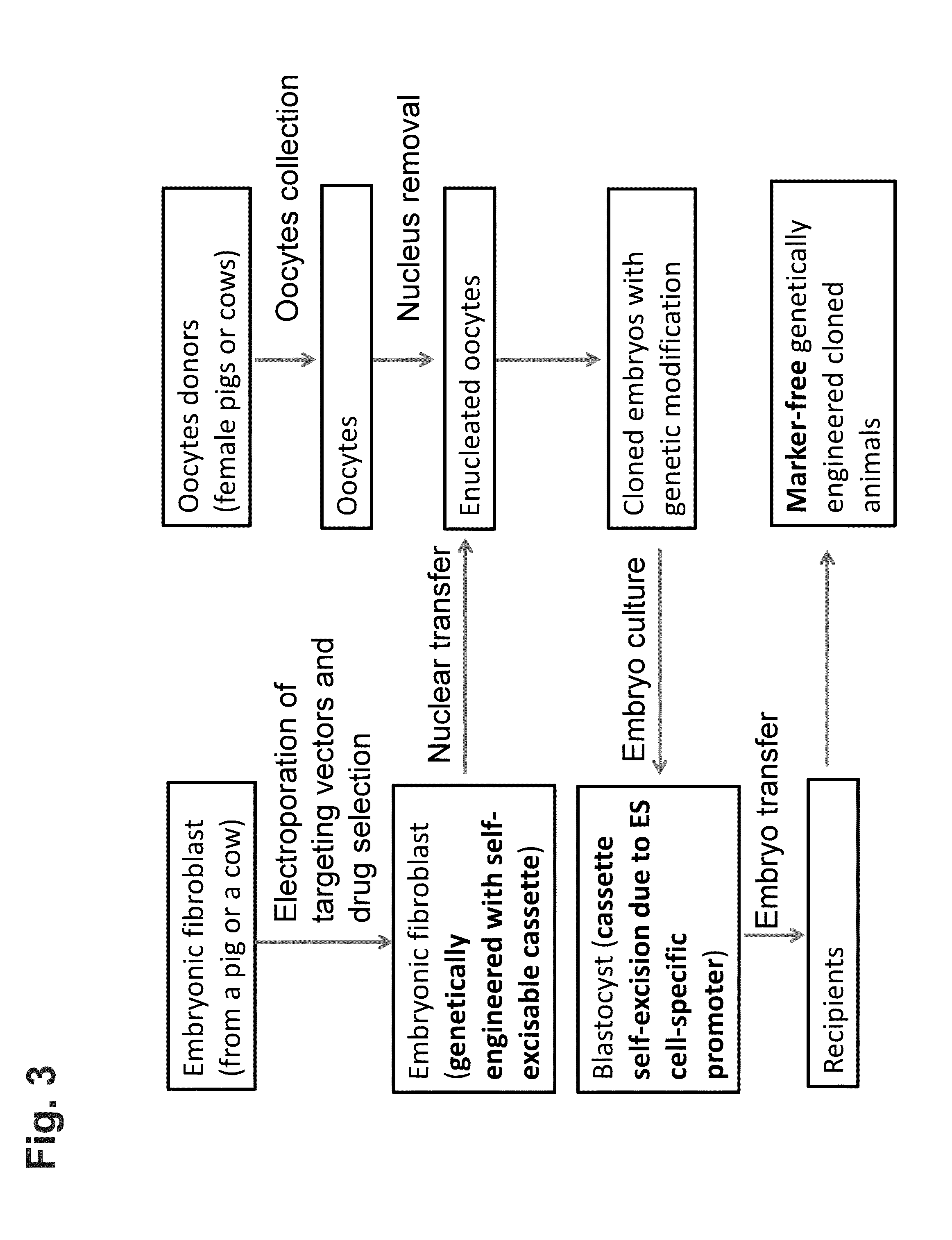Cloned non-human animals free of selective markers
a technology for cloning non-human animals and selective markers, which is applied in the field of cloning non-human animals free of selective markers, can solve the problems of low level of transfection efficiency in es cells, decreased es cell pluripotency, and selective marker gene that remains in the host genome, so as to achieve the effect of abolishing the transcription of endogenous genes
- Summary
- Abstract
- Description
- Claims
- Application Information
AI Technical Summary
Benefits of technology
Problems solved by technology
Method used
Image
Examples
example 1
Production of Heterozygous Genetically Modified Animals Free of a Selection Marker
[0178]Genetic modification is carried out in fetal fibroblasts isolated from a pig, preferably a mini pig. Using genomic DNA isolated from the pig fetal fibroblasts, a bacterial artificial chromosome (BAC) library is created, and a targeting vector containing gene of interest or portions thereof (“a targeted allele”) is designed and constructed.
[0179]In this example, the targeting vector is designed to replace all or a portion of the coding region of an endogenous target gene with a reporter gene. The targeting vector is designed to contain a self-excisable recombinase expression cassette in which both (i) a neomycin resistant gene, which is operably linked to a constitutive promoter (e.g., ubiquitin promoter) and (ii) a Cre recombinase gene (Crei), which is operably linked to an ES cell-specific promoter (e.g., Nanog promoter) are flanked 5′ and 3′ by loxP recombination sites. In addition, at the 5′ u...
example 2
Production of Homozygous Genetically Modified Animals Free of a Selection Marker
[0185]In order to produce an animal homozygous for the targeted allele, fetal fibroblasts are isolated from the animal heterozygous for the targeted allele. The targeting vector, which is used to create the heterozygous animal, is introduced into the heterozygous fetal fibroblasts via electroporation or nucleofection. The zygosity of the targeted allele is analyzed and confirmed via analytical PCR (e.g., real-time PCR) using specific probes and primers.
[0186]The fetal fibroblasts containing a genome homozygous for the targeted allele are then transferred into enucleated host oocytes. Upon fusion and activation, the cloned zygotes (which are homozygous for the target allele) are cultured in vitro until they reach the blastocyst embryonic stage. The blastocyst stage embryos are then implanted into a surrogate mother for full development into gene-targeted animals homozygous for the targeted allele.
[0187]Du...
example 3
Production of Genetically Modified Cloned Animals Using BAC Targeting Vectors
[0189]The gene targeting steps in Examples 1 and 2 can be performed using a targeting vector that has relatively short (e.g., 4 kb-8 kb) 5′ and 3′ homology arms (i.e., the sequences flanking the self-excisable recombinase expression cassette that are homologous with regions upstream and downstream of the target insertion site, respectively). In such instances, the targeting vector is typically less than 20 kb or 25 kb in size. Alternatively, the methods can be performed with bacterial artificial chromosome (BAC)-based targeting vectors, which can be up to several hundred kb in length and tend to produce fewer random integration events and aberrant targeting events (e.g., targeting events that are accompanied by gene rearrangement and / or deletions).
[0190]The use of BAC-based targeting vectors for gene targeting has been described in Valenzuela et al. (2003), Nature Biotechnology 21(6): 652-59, the contents o...
PUM
| Property | Measurement | Unit |
|---|---|---|
| disease resistance | aaaaa | aaaaa |
| size | aaaaa | aaaaa |
| fluorescent | aaaaa | aaaaa |
Abstract
Description
Claims
Application Information
 Login to View More
Login to View More - R&D
- Intellectual Property
- Life Sciences
- Materials
- Tech Scout
- Unparalleled Data Quality
- Higher Quality Content
- 60% Fewer Hallucinations
Browse by: Latest US Patents, China's latest patents, Technical Efficacy Thesaurus, Application Domain, Technology Topic, Popular Technical Reports.
© 2025 PatSnap. All rights reserved.Legal|Privacy policy|Modern Slavery Act Transparency Statement|Sitemap|About US| Contact US: help@patsnap.com



